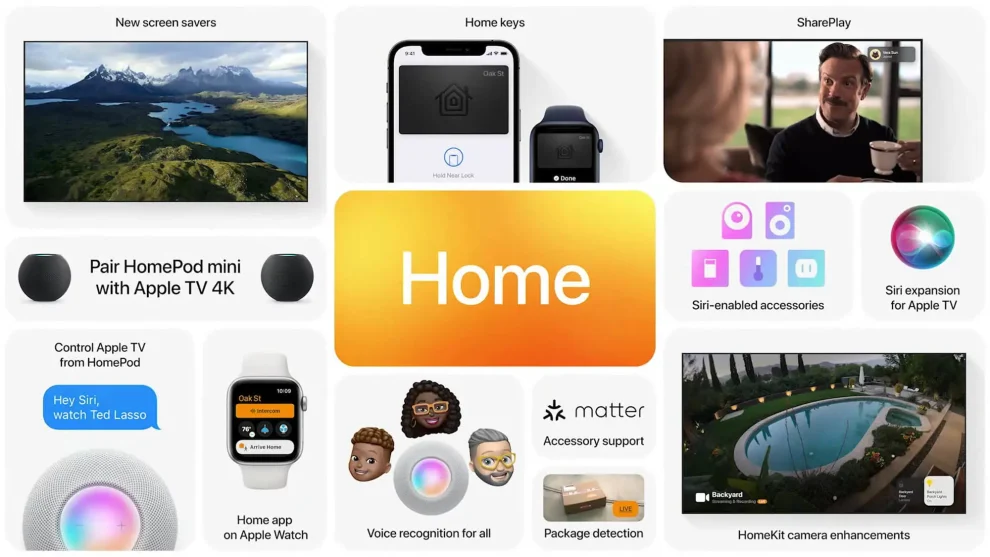Apple has revealed its ambitious new strategy dubbed ‘Screens Everywhere.’ This innovative approach aims to seamlessly integrate displays into every aspect of the home environment, potentially revolutionizing how we interact with our living spaces and digital ecosystems. As Apple sets its sights on dominating the next frontier of personal computing, the ‘Screens Everywhere‘ initiative signals a significant shift in the company’s smart home philosophy and a direct challenge to competitors like Google, Amazon, and Samsung.
Apple’s ‘Screens Everywhere’ strategy represents a paradigm shift in how the tech giant approaches the smart home market. Moving beyond standalone devices like the HomePod or Apple TV, this new vision seeks to create an immersive, interconnected ecosystem of displays that permeate every room of the house.
John Anderson, a senior analyst at Tech Insights, provides context for this strategic pivot: “Apple has always been about creating seamless experiences across devices. With ‘Screens Everywhere,’ they’re taking this philosophy to its logical conclusion, turning the entire home into an interface for digital interaction.”

Key Components of the ‘Screens Everywhere’ Strategy
While Apple has been characteristically tight-lipped about specific product details, industry insiders and leaked information provide insights into the key components of this new strategy:
1. Advanced Display Technologies
At the heart of the ‘Screens Everywhere’ concept are cutting-edge display technologies that allow for flexible, energy-efficient screens to be integrated into various surfaces throughout the home.
Dr. Sarah Chen, a materials scientist specializing in display technologies, explains: “We’re likely looking at a combination of OLED, MicroLED, and perhaps even some form of holographic display technology. The goal would be to create displays that can seamlessly blend into any surface while providing high-quality visuals and interactivity.”
Rumored applications include:
– Smart mirrors that can display weather, calendar information, and health data
– Kitchen countertops with built-in displays for recipes and meal planning
– Window panes that can transform into information displays or entertainment screens
2. Enhanced Spatial Awareness
To make the ‘Screens Everywhere’ concept truly responsive and intuitive, Apple is reportedly developing advanced spatial awareness capabilities for its devices.
The key here is creating a system that understands not just where you are in your home, but what you’re doing and what you might need,” says Maria Rodriguez, a UX designer specializing in smart home interfaces. “This could involve a combination of cameras, depth sensors, and AI to create a truly context-aware home environment.”
3. Seamless Integration with Apple’s Ecosystem
True to Apple’s philosophy, the ‘Screens Everywhere’ strategy aims to create a cohesive experience across all Apple devices and services.
Mark Thompson, a software engineer familiar with Apple’s development ecosystem, speculates: “We’re likely to see deep integration with iOS, macOS, and watchOS. Imagine starting a task on your iPhone and seamlessly transferring it to the nearest available screen in your home, whether that’s your kitchen counter or your bathroom mirror.
4. Advanced Voice and Gesture Control
To interact with screens that may not always be within easy reach, Apple is reportedly developing enhanced voice and gesture control systems.
“The goal would be to make interaction as natural as possible,” explains Dr. Lisa Patel, an expert in human-computer interaction. “This could involve a combination of voice commands, hand gestures, and even eye tracking to control the various displays around your home.”
5. Privacy-Focused Design
Given the potential privacy concerns of having screens and sensors throughout the home, Apple is placing a strong emphasis on privacy and security in its ‘Screens Everywhere’ strategy.
We’re likely to see advanced encryption, local processing of sensitive data, and granular control over what information is collected and shared,” predicts Alex Smirnov, a cybersecurity expert specializing in IoT devices.
The ‘Screens Everywhere’ concept has the potential to fundamentally change how we interact with our homes and digital information:
Home Productivity and Organization
With displays integrated into various surfaces, managing household tasks could become more intuitive and efficient. Smart kitchen surfaces could suggest recipes based on available ingredients, while a display in the entryway might show reminders and schedules as family members leave the house.
Health and Wellness
Bathroom mirrors could display health data from Apple Watches, providing daily updates on fitness goals and vital signs. Smart displays throughout the home could offer reminders for medications or suggest breaks for physical activity.
Entertainment and Social Interaction
The line between physical and digital spaces could blur, with any surface potentially becoming an entertainment center or a portal for social interaction. Windows could transform into screens for video calls, bringing distant friends and family into the home environment.
Education and Learning
Every room could become a potential classroom, with interactive displays facilitating immersive learning experiences for both children and adults.
Energy Management and Sustainability
Smart displays could provide real-time information on energy usage and suggest ways to optimize consumption, promoting more sustainable living practices.
Challenges and Concerns
While the ‘Screens Everywhere’ concept is undoubtedly ambitious, it also raises several challenges and concerns:
Privacy and Data Security
The pervasive nature of the technology raises significant privacy concerns. How will Apple ensure that the wealth of data collected by these devices remains secure and private?
Dr. Elena Rodriguez, a digital privacy advocate, warns: “With screens and sensors in every room, we’re potentially creating an unprecedented level of surveillance in our own homes. It’s crucial that users have complete control over their data and can easily understand what information is being collected and how it’s being used.”
Energy Consumption
The environmental impact of having multiple displays constantly active throughout the home could be significant.
“Energy efficiency will be a key challenge,” notes Dr. Michael Green, an environmental scientist specializing in technology sustainability. “Apple will need to develop extremely low-power display technologies and smart power management systems to make this concept environmentally viable.”
Digital Overwhelm and Mental Health
There are concerns about the psychological impact of being constantly surrounded by screens and digital information.
Dr. James Wong, a psychologist studying the effects of technology on mental health, cautions: “While the convenience is appealing, we need to consider the potential for digital overwhelm and its impact on mental well-being. There’s a risk of creating an environment where it’s impossible to disconnect from the digital world.”
Accessibility and Inclusivity
Ensuring that the ‘Screens Everywhere’ concept is accessible to all users, including those with disabilities, will be crucial.
“Apple has a strong track record in accessibility features, but this concept presents new challenges,” says Maria Gonzalez, an accessibility consultant. “They’ll need to consider how users with visual, auditory, or mobility impairments can interact with screens integrated into various surfaces.”
Market Implications and Competitive Landscape
Apple’s ‘Screens Everywhere’ strategy has significant implications for the smart home market and could reshape the competitive landscape:
Potential Market Dominance
If successful, this strategy could give Apple a significant advantage in the smart home market.
By creating a truly integrated smart home experience, Apple could lock users into their ecosystem in a way that goes beyond smartphones and computers,” predicts John Smith, a market analyst at Tech Futures. “This could make it very difficult for competitors to gain a foothold in Apple-dominated households.”
Response from Competitors
Apple’s move is likely to spur innovation and competitive responses from other tech giants:
– Google: May leverage its strength in AI and search to create more intelligent, context-aware home environments.
– Amazon: Could focus on enhancing its Alexa ecosystem and potentially partner with display manufacturers to create competing products.
– Samsung: With its experience in display technology and home appliances, Samsung could be well-positioned to develop its own version of the ‘Screens Everywhere’ concept.
Impact on Hardware Manufacturers
The ‘Screens Everywhere’ concept could have far-reaching effects on various hardware industries:
– Display Manufacturers: Could see increased demand for flexible and transparent display technologies.
– Home Appliance Companies: May need to adapt their products to integrate with smart display systems.
– Smart Home Device Makers: Could face increased competition or opportunities for partnership with Apple.
As Apple moves forward with its ‘Screens Everywhere’ strategy, several key factors will influence its success:
Developing the necessary display technologies, spatial awareness systems, and seamless integration across devices presents significant technical challenges.
Dr. Robert Chang, a technology futurist, comments: “What Apple is proposing pushes the boundaries of current technology. Success will depend on breakthroughs in areas like flexible displays, energy efficiency, and AI-driven contextual awareness.”
The success of ‘Screens Everywhere’ will ultimately depend on user acceptance and willingness to integrate these technologies into their daily lives.
“This is more than just a new gadget; it’s a new way of living,” notes Dr. Lisa Chen, a sociologist studying technology adoption. “Apple will need to clearly demonstrate the value of this ecosystem to overcome potential resistance to such a pervasive technology.”
As smart home technologies become more integrated into our lives, they’re likely to face increased regulatory scrutiny, particularly around privacy and data security.
Alex Johnson, a technology policy expert, predicts: “We’re likely to see new regulations emerge around smart home technologies. Apple’s approach to privacy and data handling will be under the microscope, and their success may depend on their ability to navigate this evolving regulatory landscape.”
Apple’s ‘Screens Everywhere’ strategy represents a bold vision for the future of smart home technology. By reimagining every surface as a potential interface, Apple is not just creating new products, but proposing a fundamental shift in how we interact with our living spaces and digital information.
While the concept faces significant technological, social, and regulatory challenges, it also offers tantalizing possibilities for enhancing productivity, health, entertainment, and sustainability in our daily lives.
As Apple moves forward with this ambitious plan, the tech industry and consumers alike will be watching closely. The success or failure of ‘Screens Everywhere’ could well determine the future direction of smart home technology and shape the way we live for years to come.
In the end, Apple’s vision of a home where digital interfaces are as ubiquitous and natural as the walls around us may seem like science fiction today. But if history is any guide, the seemingly impossible has a way of becoming reality in the world of technology. As we stand on the brink of this potential revolution in smart home technology, one thing is clear: the concept of ‘home’ is about to take on a whole new meaning in the digital age.
















Add Comment